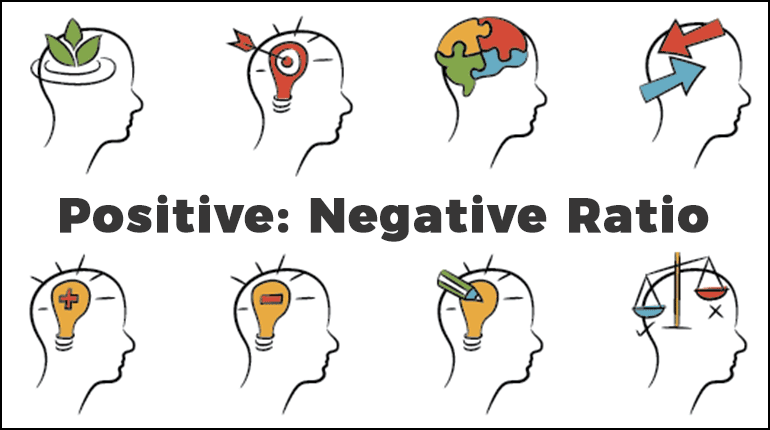Cognitive reframing involves identifying and then changing the way you look at a situation, based on “reframing” a thought. It’s about shifting your perspective to see things in a new, often more positive or realistic light. For example, instead of thinking, “I can never do anything right,” you might reframe that thought to, “I make mistakes sometimes, but I also have many successes,” or “I made a mistake, but I can learn from it.”
When our thoughts are persistent, distressing, or sucky, gentle reframing (eg 9 Thought Shifts to Try on for Size) might be a helpful tool. Reframing is what it sounds like — we are trying to “frame” what is going on in a new frame, versus the current frame.
As an example, a gentle reframe may work when we address the helpful/”helpful” intent behind worry. Research suggests that worry intentionally heightens negative feelings, acting as a buffer against further emotional hits from stressors. The idea here is that worry attempts to prevent abrupt emotional changes, especially those that tilt towards the negative. This consistent state of worry ensures that the emotional lows aren’t too far from their current state. Understanding and acknowledging worry’s role can guide towards strategies that are more truly helpful. Even knowing that sudden emotional shifts aren’t inherently harmful paves the path to breaking the worry cycle… perhaps with a gentle reframe: “It’s okay Worry, we welcome the waves… We can ride the natural flow of waves; there’s no need for you to add tumultuous waves to brace us. You can take a break. We’ve got this.”
If a gentle reframe changes how you feel in the moment. Awesome! The reframe of fear to “The adventure continues!” has done wonders for me.
But what if gentle reframing isn’t working? What if the thoughts are linked to past distressing events? What if our neurons helpfully/”helpfully” made sure that anything similar to those events (the threatening content AND other, surrounding, non-threatening content) was remembered for future, automatic helpfulness/”helpfulness”? What if part of us took on a protective role so that it could pop up to helpfully/”helpfully” protect us down the line? That’s when techniques like Internal Family Systems (IFS) and Havening may be beneficial.
Again, this post deals with reframes. If they work, wonderful. If not, be a compassionate and curious sleuth and try Internal Family Systems (IFS) and Havening. Here is a good intro post.

1. “Victor” vs. “Victim“
Long before the Property Brothers were breaking hearts by showing couples their dream home, only to tell them they couldn’t have it, there was the parable of The Mustard Seed, in which Buddha told a grieving woman that if she brought him a mustard seed from a house not touched by death, he would be able to create a concoction to bring her son back to life. Of course there was no such house to be found. (And unlike the Property Brothers, Buddha only pulled this storyline once.)
We are all touched by death, we are all touched by the beauty of life, and we are all touched by everything that falls in between. Each of us has a choice to make: VICTOR or VICTIM.
From the mouth of babes, I found myself ever-encouraged by the voice of my daughter Athena, who as a kid, would advise the procrastinating and dramatic whines of her mom to “Rub a little dirt on it.” This worked for me because humor brings you up the ladder — from a stressed (overwhelmed / sympathetic mobilized) state to the state of social engagement and safety. When we are in the middle of the ladder, or down at the bottom, the story we have about the world is grave and dire or hopeless. At the top of the ladder, it’s a better story. What can you think that can move you “up the ladder”? “Rub a little dirt on it” made me laugh, and I truly embodied the higher state. I will say though, the use of the phrase “rub a little dirt on it,” is terrible, terrible, terrible — beyond terrible — to use in general, because it teaches people that feelings are bad and you need to squash them and pretend to be happy. What’s funny to you? Yes, a thought that makes you giggle inside can be a gamechanger. Check out this TED Talk on How Humor Can Save the World.
You might also like: The Superconscious Accountability Ladder

2. “Hustling” vs “Slaving Away” (and “Flow” vs “Hustle”)
Amidst a mad scramble of running around trying to make ends meet, I was tired, stressed, losing options, and at the point of adopting a “woe is me” mindset… one that leads to resigned thoughts of how unfair this or that is, one that doesn’t give much room to see the path to better… I went to yoga class, and as everyone was settling in, one classmate asked another what he was up to. “You know, still hustling.” Hustling! That sounds so much better than the other phases I would hear from people around me (“I’m a working stiff,” “Slave to the grind,” “Run ragged,” and so forth.) At that time in my life, the word “hustling” carried a bit of excitement and adventure to it, with a dash of hope, and a sprinkle of impending triumph. Later I found that hustling was not the key to success for me, but found a different reframe helpful: replacing busy with jam-packed. Sometimes my schedule is indeed jam-packed, but it too carries lots of excitement, engagement and adventure within it. I have come to embody the “less hustle more flow” spirit, and that doesn’t equate with: do nothing and be bored. Sometimes the flow equals a jam-packed adventure.

3. “Get to” vs “Have to“
This one comes from Transformation Academy. Instead of thinking “I have to X” try thinking “I get to X.” Note that this is not about false gratitude. It’s a shift in thoughts and words. In trying this one on, I found that it also made things more fun for me. And the beauty is that, by using “I get to” in front of things I was already excited to do, it helped me relish and appreciate those things more. One example Natalie (co-founder of Transformation Academy) gave was “I get to pay my bills.” She pointed out, that this is actually a pretty good thing when you think about it. And quite a few times in life, I “got to” pay my bills by writing myself one of those blank checks from a credit card company. But guess what? I still got to pay my bills.

4. “The Obstacle is the Way” vs “Stuck“
My daughter (and co-founder) Jade loves the book The Obstacle is the Way. The title of the book is drawn from a quote from Roman emperor Marcus Aurelius: “The impediment to action advances action. What stands in the way becomes the way.” Interestingly, as I write this, videos of Randy Pausch’s talks are spreading wildly around the internet. He says: “Brick walls are there to show you how much you want it.” The full quote, I am told (by Google), is “The brick walls are there for a reason. The brick walls are not there to keep us out. The brick walls are there to give us a chance to show how badly we want something. Because the brick walls are there to stop the people who don’t want it badly enough. They’re there to stop the other people.”
And when a wall shows us that we don’t care, that’s fine. When I was getting my masters, one advisor was so keen on me switching my track from the trainer track to a teacher track, that I bought into her excitement. According to her, the additional academic effort and cost would be minimal. It seemed appealing, as I always loved kids and working with them. But then when someone higher up told me quite a different tale, I wasn’t crushed at all. I saw the brick wall (“You can’t go down this path you thought you could to be a teacher”) and shrugged with no remorse and said “Ok, I’ll continue on this trainer track that I was already on and excited about.”
In The Secret to Success, Eric Thomas says “When you want to succeed as bad as you want to breathe, then you’ll be successful.” When you come to walls along this As-Bad-As-I-Want-Yo-Breathe Path, that’s where you get to unleash your ever-hustling victor best moves and make that obstacle your way… Or if you’re the less hustle more flow type, you tap into your intuition to get the answers you need to move the obstacle out of your way, or go around it in the right way (or tap into wisdom beyond yourself).

5. “The Adventure Continues” vs “I’m Afraid” (Fear of Uncertainty)
My niece Zoey’s catchy catch phrase is “The adventure continues.” When Jade was leaving me for a Semester at Sea, I was also downgrading my apartment to a 1 bedroom at another apartment complex. The uncertainty that came with all this change tried to tug me into a black hole of fear, but I heard a voice in my head say “The adventure continues.” This has been a wonderful shift for me, and works well with Shift 2, hustling, if the term hustling floats your boat. If you are more intuitive and tuned in, then remembering to tune (even for just 3 minutes) in will likely make what’s in front of you less scary, and allow you to make spiritually aligned (love aligned) decisions that will serve you well.

(This file is licensed under the Creative Commons Attribution 3.0 Unported license. Attribution: Weatherman90 at English Wikipedia)
6. Move your “spotlight” or Turn it Off
For me, the spotlight is on my nose. I hate it. I look at my funny-enough-looking face and just see NOSE. But when I step back to think about other people’s noses, I can’t picture them. So maybe when I look in the mirror I need to move the spotlight to my eyes (which I like), or just turn the whole spotlight off and view myself through the most important eyes of all (the canine ones).
There was a study that had students wear an “embarrassing” Barry Manilow tee-shirt. When asked, the students thought that 50% of the people in a large lecture room would notice the tee, but in reality only about 25% did. People aren’t paying as much attention to our spotlights as we think. Read more about the spotlight effect here. And if you are hurting yourself by shining a spotlight on yourself, turn that darned thing off.

7. Positive vs. Negative
This one is less about positive vs. negative as a thought shift, and more about the amount of authentic positive emotions you have vs. the negative ones. The shift is not really in your thoughts. Your thoughts shift because you change your positivity ratio. (You change your home base on the polyvagal ladder.)
In her book Positivity, Dr. Barbara Fredrickson lists 10 forms of positivity: joy, gratitude, serenity, interest, hope, pride, amusement, inspiration, awe, and love. Positivity is not “Oh, my car engine is on fire, I’m so grateful that I can warm my hands.” Positivity, is feeling the genuine and authentic emotions listed above, at appropriate times. In fact, one study Dr. Fredrickson cites showed that insincere smiles fared just as well as anger in predicting cardiac events. Don’t fake it. Find it.
There are a handful of books I consider must-reads for those of us who are striving for better and betterer, and Positivity is one of them. This book is more than a what and how-to guide on positivity, it also has hundreds and hundreds of scientific studies backing up the benefits of positivity. Negativity and neutrality holds us back. With negativity, the blinders come on, your mindset narrows, behaviors are rigid and painfully predictable. Positivity opens you up — the brain is in an expansive mindset. This opens your mind and heart, makes you more creative, more receptive, stronger, wiser, more resilient and more socially integrated. You have better ideas. The biochemical stew within your body has all the good ingredients. You radiate. Your warmth is palatable. If you can spend most of your time in this mindset, the science shows you can live up to 10 years longer. Head to wherever it is you buy books and tell them “SHUT UP AND TAKE MY MONEY” and buy this book. Also head to PositivityRatio.com and find out your ratio. The goal (and don’t worry, you can work to change your ratio if you don’t like it) is to have a positive:negative ratio of 3:1 or higher (though not as high as 11:1).

8. What You Want vs. Complaints
Another book that falls into the “SHUT UP AND TAKE MY MONEY” category is Michael Neill’s Super Coach. One of his tips is to speak of what you want instead of complaining about what you don’t like. He also suggests the idea of taking 7 Day Complaint Fast. This addresses spoken complaints. If you complain, your 7 days starts over.

I honestly have not been able to successfully complete a complaint fast… YET.

9. Cheerleader vs. Sneer-leader
I was torn between Mindful vs. Mindless and this “You got this girl!” story. Some of the above shifts would deserve their own post, and we’ve already posted at length on mindfulness, so (at risk of this getting lost in translation), I decided to go with a story near and dear to my heart… the “You got this girl!” story.
Recent studies have shown that talking to yourself in the third person can help you reduce stress. Talking to yourself in the third person can also help you, apparently, make it to work and wow everyone even though your body was telling you otherwise. One of my favorite people ever, let’s call her B, attended a Thursday night business bash. Her company tends to have lots of alcohol at their events, and this was a landmark event. Lots. Of. Beer. In the face of beer, her established strategy for pacing herself was not an option (mixing wine with diet Sprite), so much like Liz Lemon on 30 Rock, she got “business drunk.” And also much like Liz Lemon on 30 Rock, she found herself “business sick” the next day. Forcing herself to show up and shine, she had a third person conversation with herself, and we’ll call that “person” C, for cheerleader, because of her keen pep talk abilities and animated enthusiasm.
EXT – CITY SIDEWALK – DAY
B: (dragging, lifeless) I’m so sick, I can’t go on.
C: (with peppy arms, elbows rising and falling enthusiastically) You got this girl. Keep going. You got this.
STREET CORNER – FIREHOUSE
While walking, B projectile vomits 12 feet forward.
Firemen: Are you okay?
A: (walking on) Yep, just the typical Friday morning walk to work.
C: (peppy arms continue) That’s right, you go girl. You got this. Got it all out of your system!
B: NoOoooO. I still feel sick.
C: (peppy arms continue) You got this. Keep going. You got this girl.
B projectile vomits 12 feet forward.
C: (peppy arms continue) Okay, okay, you got this. 7-11 is right there. Let’s get some hydrating drinks. That’s fix you right up. You got this girl!
EXT. SEVEN 11 – DAY
The two exit 7-11 with their purchase.
C: Coconut water, Gatorade, drink up you got this.
B drinks. A proceeds to projectile vomit 12 feet forward.
B: I’m too sick.
C: (peppy arms continue) No, no, no. You’ve got this girl. It’s all out of your system now. Keep going.
The two walk on to B’s work. B proceeds to vomit one final time as she approaches her building. She heads in, puts in her best effort, and gets complimented by her bosses for not being hungover after last night’s festivities.
When I heard this story, I hurt myself laughing. Moreover, Jade pointed out that the firehouse and 7-11 are only 1 block apart. I can just picture, C, like the angel on a shoulder, with peppy, marching drummer-like arms saying “You got this girl, you got this.” So I borrow her from time to time… and she tells me “You got this girl!” I love her. Not looking for a peppy cheerleader? I met a guy who adopted a line from Dumb and Dumber who would either use the direct quote from the movie: “We’re really doing it Harry!” or an altered version “We’re really doing it Kevin!” as his inner 3rd-person voice. My vote is: the more ridiculous the character, the better!